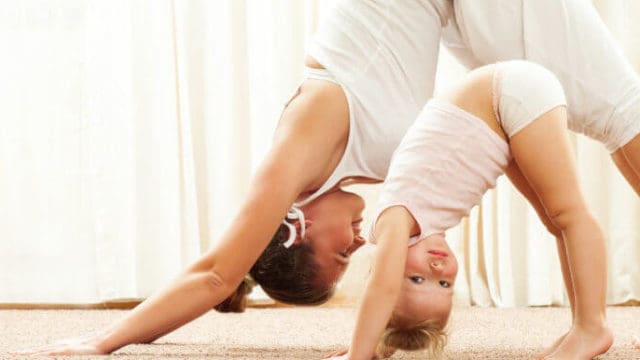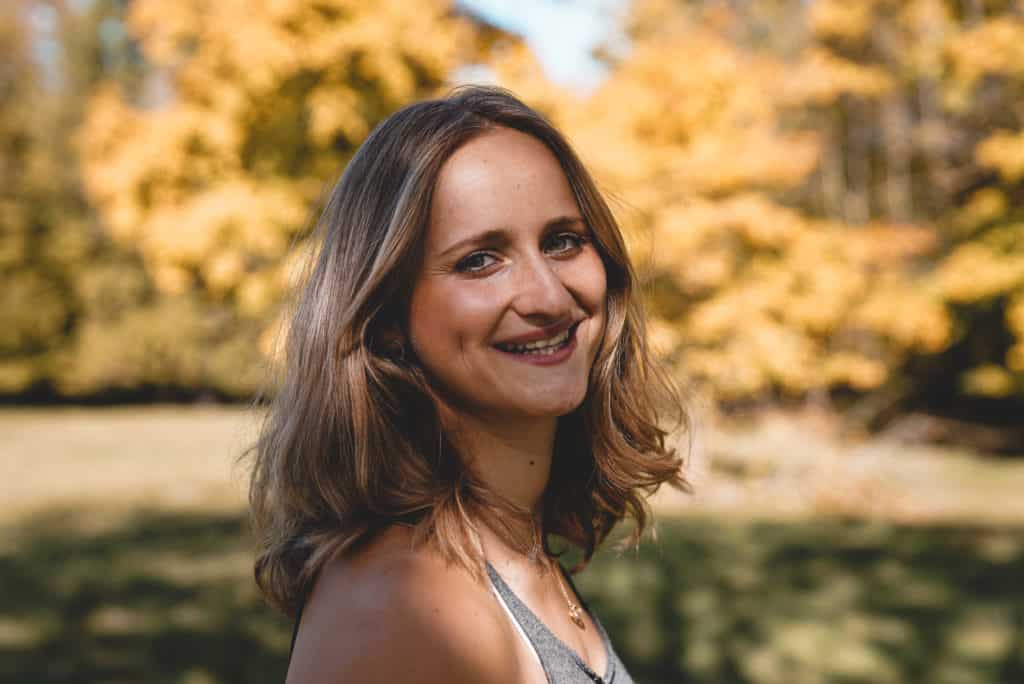
Q&A: @luisaharisch reveals parent-child yoga myths
Yoga and meditation is wishy washy! It’s not even a sport! The language is too spiritual! And only soy latte cashmere sock-wearers go to parent-child yoga classes!
You can expect all this and more when you tell fellow parents that you attend parent-child yoga. In the worst case scenario, you might get expelled from the playground for good.
You might be thinking that organic food and trilingual preschool go hand in hand with parent-child yoga, so it doesn’t really fit with your relaxed mom and dad parent styles. But is parent-child yoga just a fashion trend, or are there serious benefits to it?
We have proof that asanas aren’t just for hipster offspring because nearly 25 years ago, a primary school teacher in Berlin did yoga exercises with first-graders to reduce their stress levels – and it worked.
What began as a “yoga club” for first-graders quickly became so popular with the children that parents wanted to integrate yoga classes permanently into the schedule. Some mothers who brought their children to school in the morning were delighted to participate in “Good Morning Yoga”.

Nevertheless, there are still countless clichés and prejudices when it comes to parent-child yoga, so we took the most common myths and asked @luisaharisch, our parent-child yoga expert, for more information.
Luisa is a yoga teacher full of heart and soul. A few months ago, she gave birth to a beautiful boy and she shares her experiences regarding hormone yoga, back yoga, yoga during pregnancy, parent-child yoga and much more on her YouTube channel.
Luisa found yoga as a young girl and was able to find confidence, peace and strength through her practice. Since then, she’s taken her followers on a fascinating yogi journey through an interplay of movement, breathing and relaxation.
Myth 1 – parent-child yoga is no different from normal yoga
The basis of children’s yoga and yoga for adults is the same, only the approach is different; for example children’s yoga is imaginative and playful.
Hatha Yoga from India is directed at the perception of the child as it embodies nature, plants and animals. Many yoga movements are even named after them: tree, dog, pigeon, swan, cobra.
In a yoga class for children, the same values are taught as in adult classes, just in a different way. One difference lies in their goals.
Where many adults set individual goals or intentions for their yoga practice – from getting sweaty to learning how to chill – the intentions of the little ones can be more generalized with a focus on joy, fun and relaxation.
With children, individual asanas are performed for shorter periods of time. There are several reasons for this. Children shouldn’t and can’t hold postures for very long as they have less strength and endurance due to their smaller cardiovascular system. In addition, the effect of an asana occurs much faster in children which means they can relax much quicker.
Our children are as unique as we are – so playfully try out different styles and techniques to find out what’s good for them.
Myth 2 – Parent-child yoga is too easy
Yoga can be strenuous for both adults and children. Of course this depends on several factors such as strength, endurance, intensity level and the type of yoga. But we can all agree on one thing: yoga is a challenge on both a physical and psychological level.
Myth 3 – Parent-child yoga only stimulates the imagination of children
Yoga provides an opportunity for children to get to know themselves through practice and experience. Then, when they reach adolescence, they will have a strong alignment with their personality and enjoy lasting positive development as they grow up.
Calmness and mindfulness is learned through yoga. With the help of these qualities it will be easier for a child to acquire useful skills and handle social situations better. Children are very agile and flexible when they are young, so it’s important to work on their endurance and strength through proper yoga practice.
It’s important to remember:
- the conscious perception of the relationship between the body and the breath
- a sense of self-awareness
- respect for one’s own health limits and possibilities.
All this happens naturally within the exercises. Another advantage of yoga practice is that all senses are stimulated, so the aim of asanas is to get a feeling of stability and release tension.
With yoga, coordination, dexterity and scope of movement will be expanded. Through this you’ll learn how to trust your own body and the child will thereby gain confidence in their own strength.
The child will become more self-aware and their sense of mindfulness (in the form of appreciation towards people and animals) will also be strengthened. And, because of the group dynamics, social interaction is celebrated and encouraged.
Myth 4 – It’s difficult for children to stay focussed
My experience here is: if you create a playful, creative and flexible yoga class for your child, they won’t be bored.
Children love to be involved, so try out a few styles and find out if your child prefers long or short sequences and positions. Maybe you prefer to practice in the morning instead of in the evening and maybe you can build a massage into the final relaxation, pampering your child and strengthening your bond at the same time.
Find something you both enjoy! And do what feels right for you, otherwise your child will feel your discomfort. As long as you’re both enjoying it, the good vibes and happy feelings will follow. Maybe you can even establish a routine for the whole family!
Myth 5 – Real men don’t do parent-child yoga
The beautiful thing about yoga is that it’s so multi-faceted. Almost anyone can practice yoga, even with physical limitations, and even then you simply adjust the exercises so they work with your limits.
You can even do yoga with your baby while they lie next to you on the mat. It’s fun with a toddler too, because they’ll want to get involved and do gymnastics all over you! Just let it happen.
You can do short sequences and when your child gets in the way of your movements, you can involve them in a relaxed and easy way. Maybe just start with two easy asanas and then increase your movements as you wish.
If your child is already in kindergarten or primary school, then you can try small sequences, i.e. a series of several asanas in a row.
Just try a sun salutation or go on an imaginary world trip/safari with your child and see which animals you meet.
Whether you’re a mum, dad or child, you’ll all feel refreshed, rejuvenated and full of energy after parent-child yoga. I wish you a lot of joy and all the love – your Luisa!
Q&A
With Q&A we get to the bottom of controversial topics every two weeks! Now it’s your turn. If you have further questions for our expert Luisa, just ask her via our Instagram channel. @luisaharisch will answer your questions on her Live Talk on Thursday, June 11th at 8pm, live from her channel as well as ours.



Comments